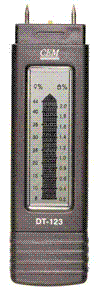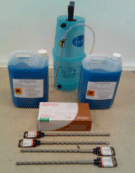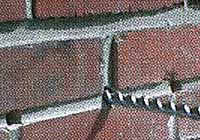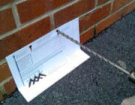Until recently, installing extensive damp proof courses was too costly for large projects or thick walls due to the challenges of high-pressure injection.
The equipment is expensive, and even professionals face issues like blowbacks, fluid loss through fissures, and sealing problems in crumbling masonry.
Previously, hiring a damp proofing company and paying for expensive replastering was the only option.
This guide explores the modern technique of damp proof injection that can be done on a DIY basis. Read on to find out more.
What is a Damp Proof Course?
One common cause of damp issues in the home is an ineffective damp proof course (DPC). A damp proof course is a barrier between the ground and the walls of your home.
They are usually made of plastic or bitumen, that is installed as a layer between the bricks that form the walls of your home, near the base, roughly usually 6 inches or so up from ground level.
The installation of this waterproof barrier prevents water and moisture that naturally occurs in the ground from travelling up through the walls and causing untold issues and damage to the interior surfaces of your home.
In some instances, these barriers can fail for a number of reasons; damage, wear over time, puncturing and when this happens, the afore mentioned water and moisture can travel up through the walls of your home, creating damp patches on interior walls, damaging plaster and causing many other issues.
Traditionally, the only real fix was to remove bricks from above the existing DPC and replace/repair it, which was massively time consuming and expensive. However today, the development of injectable damp proof courses has created a much cheaper and accessible fix that can be done on a DIY basis.
Damp Issues Caused by Ineffective Damp Proof Course
As we have mentioned above, an ineffective DPC allows moisture from the ground to seep into and up the walls of your home. This can cause visible damp patches, peeling paint and wallpaper and damaged and blown plaster.
If allowed to persist, over time, the moisture can lead to structural issues, weakening the mortar and bricks. In severe cases, it can even cause significant damage to the foundation of your home!
Another consequence of a failing damp proof course is the development of mould and mildew. These fungi thrive in damp environments and can spread rapidly, causing health issues such as respiratory problems and allergies. Mould growth can also damage household items, such as furniture and clothing, and create an unpleasant musty odour throughout the house.

Damp issues cause by failed damp proof course
Identifying a Failed Damp Proof Course
Identifying a failed damp proof course (DPC) is crucial for maintaining the integrity and health of your home. Recognizing the signs of a failed DPC early can save you time and money on extensive repairs.
The most obvious sign of a failed damp proof course is the presence of damp patches on the interior walls of your home. These are typically near floor level.
These patches may feel wet to the touch and can cause wallpaper to peel or paint to bubble. You might also notice a tide mark on the wall, usually up to, but no more than a meter above the floor, which indicates where the moisture has risen.
Another common indicator is the presence of mould and mildew. These fungi love damp conditions and can appear as black, green, or white spots on walls, floors, and even furniture.
Efflorescence is another sign. This appears as a white, powdery substance on your walls. This occurs when water seeps through the wall and dissolves salts, which then crystallise on the surface as the water evaporates. Efflorescence is unsightly and can lead to further deterioration of wall covering, especially plaster..
Musty odours are also a tell-tale sign of damp issues. If you notice a persistent damp smell in your home, it could be due to moisture trapped within the walls. This odour is often accompanied by a general feeling of dampness in affected rooms, making them uncomfortable to live in.

Tide mark on wall indicating a failed damp proof course
What is Damp Proof Course Injection?
Damp proof course (DPC) injection is a modern method used to combat rising damp in buildings. Rising damp occurs when moisture from the ground seeps up through the walls, leading to structural damage, mould growth, and many other issues in the home, including potential health issues!
The emergence of injectable damp proof courses over the past few years has meant a cost effective and accessible repair that can be done on a DIY basis, saving both a great deal of time and money.
The process of DPC injection involves drilling a series of small holes at regular intervals along the base of the affected walls. These holes are then filled with a special damp proofing fluid, usually a silicone-based solution. This fluid spreads through the masonry, creating or recreating a waterproof barrier that prevents further moisture from rising through the walls. Once the injection is complete, the holes are sealed, and the wall begins to dry out over time.
One of the main advantages of DPC injection is its minimally invasive nature. Unlike traditional methods, which might require extensive excavation or structural alterations, DPC injection can be completed with minimal disruption to your home. It is also a relatively quick process, often taking just a few days to complete, depending on the size of the affected area.
Another benefit is its effectiveness. Modern DPC injection fluids are designed to penetrate deeply into the masonry, ensuring a long-lasting barrier against rising damp. This makes it a reliable solution for both old and new buildings. Additionally, DPC injection is a cost-effective option compared to other, more traditional damp proofing methods, making it accessible for many homeowners.
However, it’s important to ensure that the injection is carried out correctly. Proper application is crucial to the success of the treatment, as incorrect injection can lead to incomplete barriers and continued damp issues.
If you don’t feel confident in carrying out the work yourself, a professional damp proofing company will have the necessary tools and expertise to assess the problem accurately and apply the DPC injection effectively.

Injecting DPC cream into wall
Does Damp Proof Course Injection Work?
In short, yes, modern damp proof injection solutions do indeed work and can effectively repair or replace damaged or ineffective existing damp proof courses.
However, it’s success does heavily depend on the fact of whether it has been installed correctly!
If the barrier is not injected correctly and evenly across the base of a given wall and there are gaps then any ground water or moisture will easily find these gaps and continue to cause issues and damage to interior surfaces.
So above all, for a successful fix, it has to be done correctly so if you are in any doubt as to whether you are able to do this, you’re best off getting the professionals in!
Main Features and Benefits of Cream DPC Damp Proof Injection
- Quick and Easy to Install – Drill holes, clear out dust, and inject the cream. It’s that simple!
- No Wastage – Buy cream in bulk and use an inexpensive hand pump for application.
- Low Hazard – Many creams are environmentally safe with no health warnings.
- No Mess – Creams do not leak or stain, ensuring a clean application.
- Simple Hand Pump – Hand pumps offer control without the hassle of cords or recharging.
- 2nd Generation Technology – Advanced emulsion uses active ingredients efficiently.
How to Check for Damp Using a Damp Meter
As we have mentioned above, one of the key tell-tale signs of a failed damp prof course are damp patches appearing on the interior walls of your home and aside from testing to confirm damp by using the palm or back of your hand, another method is to use a damp meter.
These relatively cheap and effective tools can be purchased from pretty much every DIY store for as little as £10 – £15.
To use them, they feature a set of prongs on the base and you simply poke the prongs into the wall where the damp exits and leave it for a set amount of time and it will produce a read out on the LCD display indicating the volume of damp present.
You may also find a damp meter useful, for checking the location, extent and pattern of dampness.
These factors can affect the remedial work that is necessary – with your own meter and some technical advice you can minimise any costs involved in successfully injecting a new DPC.

Damp meter for checking the moisture content of objects
Another very handy tool is the Hygrometer. This tool is essential for measuring air temperature and relative humidity, crucial for addressing condensation and black mould issues.
Once positioned in a room, the metre will measure the relative humidity and on the LCD display, indicate this along with (in most cases) air temperature and percentage of moisture present.
Tis is another good indicator of whether damp is present in your room and to what levels.

Hygrometer for testing the moisture content in a room space
What not to do When Injecting a Damp Proof Course
As we have mentioned several times in the above information, the key to success with this project is getting it absolutely correct to ensure a full and even barrier is created, so with this in mind, here’s some pointers to keep in mind:
- Do not inject the solution into the bricks or blocks, it should be injected into the mortar course.
- If there is already an existing working damp proof course, do not inject a chemical one!
- Do not be tempted to use any pre-drilled or existing holes, always make your own to the correct specifications.
- Do not be tempted to insert a chemical damp proof course into poof quality, crumbling existing mortar
- If there are bridged cavities present, injecting a new DPC simply won’t work!
Damp Proof Course Injection Required Tools and Products
As mentioned, with the advanced in technology today it is now possible to buy all the items you need for your DIY damp proof course injection. Some can be bought as kits or in individual quantities as required to complete the job. The essential items are as follows:
- Chemical or cream damp proof course.
- Hand operated pump.
- Drilling template.
- 12mm diameter masonry drill bit or size stated by manufacturer.
- Suitable drill for drilling injection holes. In most cases an SDS drill.
- Vacuum cleaner

DPC cream injection system with quick hand pump – no special tools required
How to Inject a Damp Proof Course
Now that we have looked at all of the requirements of injecting damp prof courses and all the aspects involved, it’s now time to look at how to do the job in question.
Depending on the type of wall you have will depend on whether you just have to inject once or both internally and externally:
- Solid Stone Wall (thin): If not too thick and the manufacture states that the solution will penetrate the full wall, only need to inject from the inside or outside once.
- Solid Stone Wall (thick): If particularly thick and tea solution will not penetrate the full width, you will need to inject both from inside and outside.
- Cavity Wall: If you have a cavity wall you will need to inject both inside and outside to treat both cavity walls.
Step 1 – Prepare the Area
The first job is to correctly prepare the area and this involves clearing all walls so they are fully accessible, free from furniture, plant pots, moss and other similar growths etc.
If external walls are grubby, brush them all off and ensure they are dry.
Step 2 – Apply the Drilling Template and Drill Holes
Next with all accessible walls, you can now apply the drilling template. This will dictate where any and all holes should be drilled. You should get one included with your DPC kit. If not, contact the manufacturer and get them to confirm hole height from floor level and how they should be spaced.
Place the drilling template as instructed (should be similar to the below image) and either mark each hole with a suitable pen (Sharpie or similar) and then drill out each hole after marking all or you can place the template and drill out each hole in turn.

Drilling a 12mm diameter hole ready for DPC injection
Drill each hole to the correct depth as stated by the manufacturer and then either blow out or preferably vacuum out each hole to clear it.
As a rough guide, each hole should be drilled as follows:
- Holes should be spaced 4.5 inches apart
- Holes should be drilled 3 inches deep
- Drill all required holes before you start to inject your DPC cream

DPC Injection made easy with a drilling template – the correct level every time
Step 3 – Inject the Damp Proof Course
The next task is to now inject the DPC cream into each hole. Start by filling the applicator gun or system with the DPC cream or solution as instructed by the manufacturer.
A hole at at a time, insert the applicator nozzle into a hole and drive the solution into the hole carefully and slowly and directed. Ensure each hole is totally full before moving on to the next.
Step 4 – Fill the Holes
Once all the holes have been injected with solution, the next task is to fill each hole over and seal it up.
In the majority of cases this is done using a sand and cement mortar mix but some systems use a silicone sealant, however the best and longest lasting solution is to use a mortar mix.
Mix the mortar as directed by the instructions and fill each hole fully sealing it and then level it off with the surrounding walls surface so that it can be painted afterwards and will then be fully invisible.
Step 5 – Leave to Cure
Penultimately, the next job is to simply leave the everything to fully dry out and cure.
This includes the injected DPC solution in the wall and also the mortar mix filling the hole.
To ensure everything dries fully, it’s best to leave it for at least 24 hours.
Step 6 – Carry out Remedial/Repair Works
After everything has fully cured and dried out, finally any remedial repair work can then be carried out. This includes replacement of exterior render or interior plaster.
If you have been lucky enough to catch it in time, final repair work may just be as simple as re-hanging some wall paper or repainting a wall.
Rectifying a failed damp proof course is absolutely paramount as if it’s left, it will only create more extreme damage which will ultimately come at a greater cost involving a lot more hassle, so if you suspect you have DPC issues, get them sorted asap!

